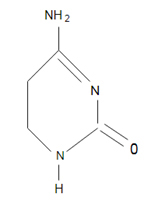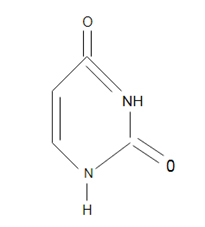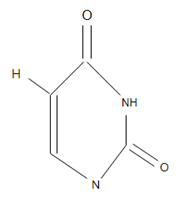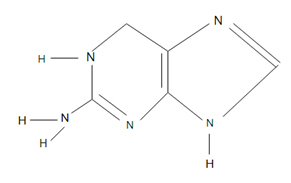
Concept explainers
(a)
Interpretation:
DNA
It stands for deoxyribonucleic acid and it has four nitrogen bases adenine, thymine cytosine and guanine, it is double stranded and lacks of oxygen.
RNA
It stands for ribonucleic acid and it has four nitrogen bases adenine, uracil cytosine and guanine. it is single stranded and can leave the nucleus.
Concept introduction:
Cytosine is one of the four bases found in . The structure of cytosine is

To determine:
Cytosine is found in DNA only, RNA only or both DNA and RNA.
(b)
Interpretation:
DNA
It stands for deoxyribonucleic acid and it has four nitrogen bases adenine, thymine cytosine and guanine, it is double stranded and lacks of oxygen.
RNA
It stands for ribonucleic acid and it has four nitrogen bases adenine, uracil cytosine and guanine. it is single stranded and can leave the nucleus.
Concept introduction:
Adenine is one of the two purine nucleases with structural formula is .
To determine: if adenine found in DNA only, RNA only or both DNA and RNA.
(c)
Interpretation:
DNA
It stands for deoxyribonucleic acid and it has four nitrogen bases adenine, thymine cytosine and guanine, it is double stranded and lacks of oxygen.
RNA
It stands for ribonucleic acid and it has four nitrogen bases adenine, uracil cytosine and guanine. it is single stranded and can leave the nucleus.
Concept introduction:
Uracil is one of the four nucleases in the nucleic of that are represented by the letters .
The structure formula of Uracil is

To determine: If uracil found in DNA only, RNA only or both DNA and RNA.
(d)
Interpretation:
DNA
It stands for deoxyribonucleic acid and it has four nitrogen bases adenine, thymine cytosine and guanine, it is double stranded and lacks of oxygen.
RNA
It stands for ribonucleic acid and it has four nitrogen bases adenine, uracil cytosine and guanine. it is single stranded and can leave the nucleus.
Concept introduction:
Thymine is one of the four nucleobases in the
The structure of thymine is as follows.

To determine: If thymine found in DNA only, RNA only or DNA and RNA both.
(e)
Interpretation:
DNA
It stands for deoxyribonucleic acid and it has four nitrogen bases adenine, thymine cytosine and guanine, it is double stranded and lacks of oxygen.
RNA
It stands for ribonucleic acid and it has four nitrogen bases adenine, uracil cytosine and guanine. it is single stranded and can leave the nucleus.
Concept introduction:
Guanine is one of the four main nucleobases found in the nucleic acid. The structure of guanine is as follows.

To determine: If guanine found in DNA only, RNA only or both DNA and RNA.
Want to see the full answer?
Check out a sample textbook solution
Chapter 21 Solutions
General, Organic, and Biological Chemistry: Structures of Life (5th Edition)
- In an experiment, the viscosity of water was measured at different temperatures and the table was constructed from the data obtained. a) Calculate the activation energy of viscous flow (kJ/mol). b) Calculate the viscosity at 30°C. T/°C 0 20 40 60 80 η/cpoise 1,972 1,005 0,656 0,469 0,356arrow_forwardDon't used Ai solutionarrow_forwardLet's see if you caught the essentials of the animation. What is the valence value of carbon? a) 4 b) 2 c) 8 d) 6arrow_forward
- A laser emits a line at 632.8 nm. If the cavity is 12 cm long, how many modes oscillate in the cavity? How long does it take for the radiation to travel the entire cavity? What is the frequency difference between 2 consecutive modes?(refractive index of the medium n = 1).arrow_forwardA laser emits a line at 632.8 nm. If the cavity is 12 cm long, how many modes oscillate in the cavity? How long does it take for the radiation to travel the entire cavity? What is the frequency difference between 2 consecutive modes?(refractive index of the medium n = 1).arrow_forwardThe number of microstates corresponding to each macrostate is given by N. The dominant macrostate or configuration of a system is the macrostate with the greatest weight W. Are both statements correct?arrow_forward
- For the single step reaction: A + B → 2C + 25 kJ If the activation energy for this reaction is 35.8 kJ, sketch an energy vs. reaction coordinate diagram for this reaction. Be sure to label the following on your diagram: each of the axes, reactant compounds and product compounds, enthalpy of reaction, activation energy of the forward reaction with the correct value, activation energy of the backwards reaction with the correct value and the transition state. In the same sketch you drew, after the addition of a homogeneous catalyst, show how it would change the graph. Label any new line "catalyst" and label any new activation energy.arrow_forwardHow many grams of C are combined with 3.75 ✕ 1023 atoms of H in the compound C5H12?arrow_forwarde. f. CH3O. יון Br NaOCH3 OCH 3 Br H₂Oarrow_forward
 ChemistryChemistryISBN:9781305957404Author:Steven S. Zumdahl, Susan A. Zumdahl, Donald J. DeCostePublisher:Cengage Learning
ChemistryChemistryISBN:9781305957404Author:Steven S. Zumdahl, Susan A. Zumdahl, Donald J. DeCostePublisher:Cengage Learning ChemistryChemistryISBN:9781259911156Author:Raymond Chang Dr., Jason Overby ProfessorPublisher:McGraw-Hill Education
ChemistryChemistryISBN:9781259911156Author:Raymond Chang Dr., Jason Overby ProfessorPublisher:McGraw-Hill Education Principles of Instrumental AnalysisChemistryISBN:9781305577213Author:Douglas A. Skoog, F. James Holler, Stanley R. CrouchPublisher:Cengage Learning
Principles of Instrumental AnalysisChemistryISBN:9781305577213Author:Douglas A. Skoog, F. James Holler, Stanley R. CrouchPublisher:Cengage Learning Organic ChemistryChemistryISBN:9780078021558Author:Janice Gorzynski Smith Dr.Publisher:McGraw-Hill Education
Organic ChemistryChemistryISBN:9780078021558Author:Janice Gorzynski Smith Dr.Publisher:McGraw-Hill Education Chemistry: Principles and ReactionsChemistryISBN:9781305079373Author:William L. Masterton, Cecile N. HurleyPublisher:Cengage Learning
Chemistry: Principles and ReactionsChemistryISBN:9781305079373Author:William L. Masterton, Cecile N. HurleyPublisher:Cengage Learning Elementary Principles of Chemical Processes, Bind...ChemistryISBN:9781118431221Author:Richard M. Felder, Ronald W. Rousseau, Lisa G. BullardPublisher:WILEY
Elementary Principles of Chemical Processes, Bind...ChemistryISBN:9781118431221Author:Richard M. Felder, Ronald W. Rousseau, Lisa G. BullardPublisher:WILEY





